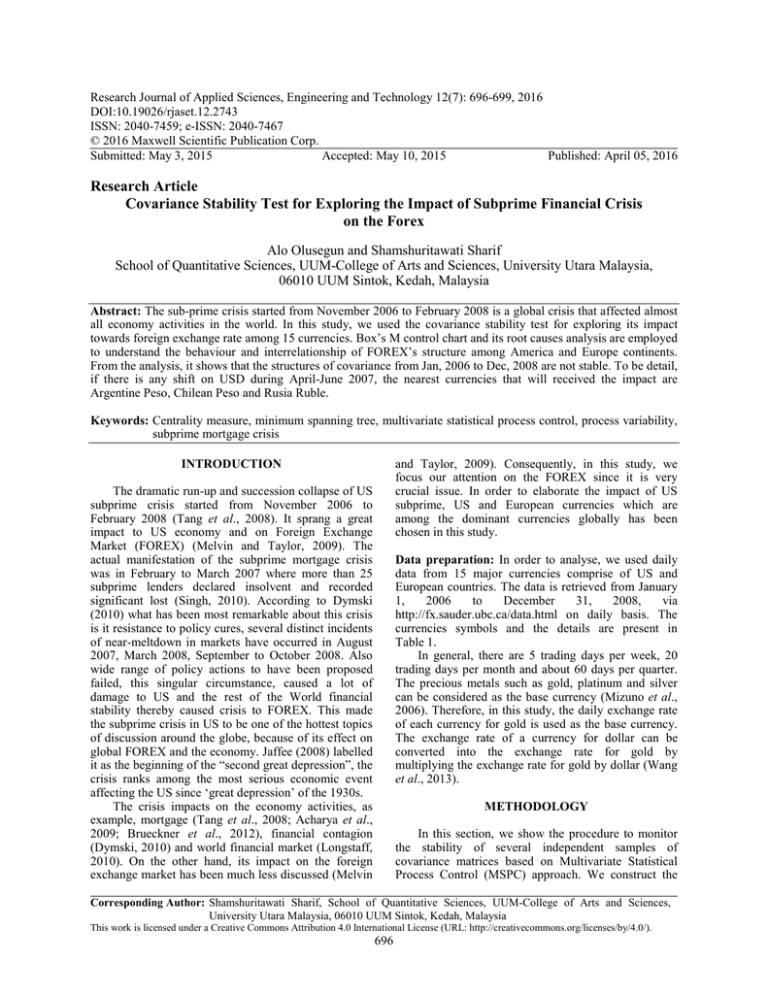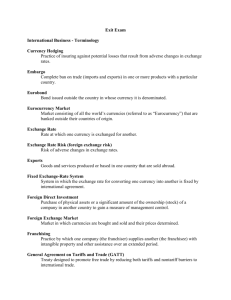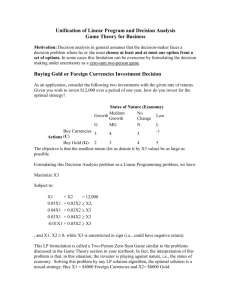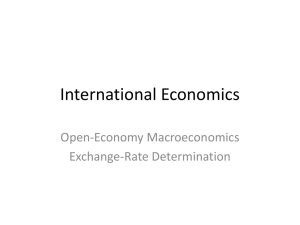Research Journal of Applied Sciences, Engineering and Technology 12(7): 696-699,... DOI:10.19026/rjaset.12.2743
advertisement

Research Journal of Applied Sciences, Engineering and Technology 12(7): 696-699, 2016 DOI:10.19026/rjaset.12.2743 ISSN: 2040-7459; e-ISSN: 2040-7467 © 2016 Maxwell Scientific Publication Corp. Submitted: May 3, 2015 Accepted: May 10, 2015 Published: April 05, 2016 Research Article Covariance Stability Test for Exploring the Impact of Subprime Financial Crisis on the Forex Alo Olusegun and Shamshuritawati Sharif School of Quantitative Sciences, UUM-College of Arts and Sciences, University Utara Malaysia, 06010 UUM Sintok, Kedah, Malaysia Abstract: The sub-prime crisis started from November 2006 to February 2008 is a global crisis that affected almost all economy activities in the world. In this study, we used the covariance stability test for exploring its impact towards foreign exchange rate among 15 currencies. Box’s M control chart and its root causes analysis are employed to understand the behaviour and interrelationship of FOREX’s structure among America and Europe continents. From the analysis, it shows that the structures of covariance from Jan, 2006 to Dec, 2008 are not stable. To be detail, if there is any shift on USD during April-June 2007, the nearest currencies that will received the impact are Argentine Peso, Chilean Peso and Rusia Ruble. Keywords: Centrality measure, minimum spanning tree, multivariate statistical process control, process variability, subprime mortgage crisis and Taylor, 2009). Consequently, in this study, we focus our attention on the FOREX since it is very crucial issue. In order to elaborate the impact of US subprime, US and European currencies which are among the dominant currencies globally has been chosen in this study. INTRODUCTION The dramatic run-up and succession collapse of US subprime crisis started from November 2006 to February 2008 (Tang et al., 2008). It sprang a great impact to US economy and on Foreign Exchange Market (FOREX) (Melvin and Taylor, 2009). The actual manifestation of the subprime mortgage crisis was in February to March 2007 where more than 25 subprime lenders declared insolvent and recorded significant lost (Singh, 2010). According to Dymski (2010) what has been most remarkable about this crisis is it resistance to policy cures, several distinct incidents of near-meltdown in markets have occurred in August 2007, March 2008, September to October 2008. Also wide range of policy actions to have been proposed failed, this singular circumstance, caused a lot of damage to US and the rest of the World financial stability thereby caused crisis to FOREX. This made the subprime crisis in US to be one of the hottest topics of discussion around the globe, because of its effect on global FOREX and the economy. Jaffee (2008) labelled it as the beginning of the “second great depression”, the crisis ranks among the most serious economic event affecting the US since ‘great depression’ of the 1930s. The crisis impacts on the economy activities, as example, mortgage (Tang et al., 2008; Acharya et al., 2009; Brueckner et al., 2012), financial contagion (Dymski, 2010) and world financial market (Longstaff, 2010). On the other hand, its impact on the foreign exchange market has been much less discussed (Melvin Data preparation: In order to analyse, we used daily data from 15 major currencies comprise of US and European countries. The data is retrieved from January 1, 2006 to December 31, 2008, via http://fx.sauder.ubc.ca/data.html on daily basis. The currencies symbols and the details are present in Table 1. In general, there are 5 trading days per week, 20 trading days per month and about 60 days per quarter. The precious metals such as gold, platinum and silver can be considered as the base currency (Mizuno et al., 2006). Therefore, in this study, the daily exchange rate of each currency for gold is used as the base currency. The exchange rate of a currency for dollar can be converted into the exchange rate for gold by multiplying the exchange rate for gold by dollar (Wang et al., 2013). METHODOLOGY In this section, we show the procedure to monitor the stability of several independent samples of covariance matrices based on Multivariate Statistical Process Control (MSPC) approach. We construct the Corresponding Author: Shamshuritawati Sharif, School of Quantitative Sciences, UUM-College of Arts and Sciences, University Utara Malaysia, 06010 UUM Sintok, Kedah, Malaysia This work is licensed under a Creative Commons Attribution 4.0 International License (URL: http://creativecommons.org/licenses/by/4.0/). 696 Res. J. Appl. Sci. Eng. Technol., 12(7): 696-699, 2016 Table 1: Countries and their symbols Continent Countries Europe United Kingdom Czech Rep Hungary Iceland Poland Russia Sweden Switzerland Romanian Norway Symbol GBP CZK HUF ISK PLN RUB SEK CHF RON NOK Continent America 01 = Testing the equality of covariance matrices: To test the stability of several independent samples of covariance matrices, we employ Box’s M statistic (Box, 1949), with the null and alternative hypothesis, : ∑ = ∑ and : ∑ ≠ ∑ respectively (Aitchison et al., 1977), pg.155 and (Mardia et al., 1979), pg.140. The Box’s M statistic with the asymptotic distribution ()()/ is as follows: M = Υ∑ ( − 1)log│"# where, • • • • Υ = 1- "= "# = $ % &()() ( '* +*, '$ +$ ) "# = ' ' '( (∑') "# │ '( - 81 = 92(1 − 01 ) (3) (4) To visualize, simplify and summarize the important information contained in the network represented by ;, we use the notion of Sub-Dominance Ultrametric (SDU) as suggested in Mantegna and Stanley (2000). Let ∆ be a matrix 15×15 with =1 as the element in >?ℎ and A-?ℎ column. We call ∆ the SDU matrix of ; if =1 is an ultrametric distance between the >-?ℎ and A-?ℎ Currencies and =1 ≤ 81 for > and A. By ultrametric distance we mean that (i) =1 ≥ 0 and =1 =0⇔ E = E1 , (ii) =1 = =1 for all > and A and (iii) =1 ≤ maxF= , =1 G for all >, A and H = 1, 2… 15. SDU is determined by a network analysis of the original network (Benzecri, 1982; Tabak et al., 2010). In this study, network analysis will be determined by using Kruskal algorithm (Kruskal, 1956). To interpret the network analysis, degree centrality is used to understand the importance and or influence of each currencies to the others (Sieczka and Holyst, 2009). The degree centrality can be defined as the number of links that a given currencies has. Specifically, the degree of node > is, 8 = ∑'1) I1 (Borgatti, 1995). Based on degree centrality, the higher the number of links is the most dominance of that particular currency. ) ' " " '( "- and "# are the unbiased estimators Network topology: Several techniques have been developed that assist in the interpretation of out-ofcontrol signals, example in, principal component analysis, neural network and network analysis. In this study, network analysis is used to identify the dominance currency causes and out-of-control signal. Based on correlation matrix, we construct network analysis of 15 currencies using Kruskal’s algorithm (Kruskal, 1956) to show the interrelationship, behaviour and inter-connectivity among currencies (Mizuno et al., 2006). By using a Matlab version 7.8.0 (R2012b) and Pajek software (Batagelj and Mrvar, 2011), we illustrate the graphical formation to simplify the difficult structure in a modest way. Then, the data is transform into price returns logarithmic exchange rate . : . (t) = ln / (t+1) -ln / (t) ∑(2( 23 ) – (∑ 2( )(∑ 23 ) 56(∑ 2( $ )( ∑ 2( )$ 76(∑ 23 $ )( ∑ 2 )$ 7 Then transform the correlation matrix to a distance matrix 81 in other to analyse the network topology (Mantegna and Stanley, 2000) that satisfies the formula and its properties: (1) ' Symbol ARS USD BRL COP CLP / (t) is daily exchange rate of currency i at the time t, i = 1, 2, …, 15. After that, the correlation matrix, 01 is computed: control chart with the upper control limit so as to identify the stability (or instability) of the FOREX during the US subprime crisis. In order to examine the root causes of any out-of-control signal, network analysis is performed (Sharif and Djauhari, 2011). Countries Argentina United States Brazil Colombia Chile RESULTS AND DISCUSSION In this section, we compute the Box’s M statistic of 15 currencies for 12 quarters. Table 2 presents the results of the analysis. At the first quarter (Jan-Mar 2006), it shows that the value is 508 where larger than (2) 697 Res. J. Appl. Sci. Eng. Technol., 12(7): 696-699, 2016 Table 2: Box’s M statistic of 15 currencies No. Quarterly 1 Jan-Mar 06 2 Apr-Jun 06 3 Jul-Sept 06 4 Oct-Dec 06 5 Jan-Mar 07 6 Apr-Jun 07 7 Jul-Sept 07 8 Oct-Dec 07 9 Jan-Mar 08 10 Apr-Jun 08 11 Jul-Sept 08 12 Oct-Dec 08 Table 3: Degree centrality measures Currency ARS-Argentine Peso BRL-Brazilian Real GBP-British Pound CHF-Swiss Franc CLP-Chilean Peso COR-Colombian Peso CZK-Czech Republic Koruna HUF-Hungarian Forint ISK-Icelandic Krona NOK-Norwegian Krone PLN-Polish Zloty RON-Romanian Leu RUB-Rusia Ruble SEK-Swedish Krona USD-US Dollar Box’s M Statistic 508 456 610 638 677 691 568 581 570 535 433 455 Degree centrality 1 3 1 3 2 1 1 1 1 2 2 1 5 1 3 root causes analysis of an out-of-control signal can help us to search the most dominance currency, we present the network analysis based on 6th quarter (April-June 2007) in Fig. 2. By using Kruskal algorithm as a filtering procedure, it produces 14 numbers of links to be interacting between all the currencies. This figure show that interrelationship among the currencies is more conclusive when it can be visualised via network. To elaborate the findings more clearly, we present the results of degree centrality measures in Table 3. The colour of the nodes represents the scores of centrality measure and the rank of importance, respectively. Based on network analysis in Fig. 2, we learn that network analysis has well split 15 countries into two continents which are America (round nodes) and Europe (square nodes) excluding Iceland. We can see that RUB and USD are the cause of two different continents has been linked. From degree centrality, RUB (purple point) has the highest number of links 5 in the network. Each of the following currencies has 3 links: BRL, USD and CHF (orange points), then CLP, NOK and PLN (green points) have 2 links, respectively. The following currencies (black points) ARS, GBP, COR, CZK, HUF, ISK, RON and SEK are of 1 link only. As a conclusion, RUB is the most dominance currency that controls CHF, GBP, PLN, CZK and USD. Fig. 1: Control chart for Box’s M statistic .K, = 95.7046. Therefore we reject the hypothesis since it is fall outside 95.7046. To illustrate all the 12 quarters in simple manner, we use an MSPC approach for the next step. We construct the control chart to monitor the covariance stability where its upper control limit is .K, = 95.7046 (plotted in red line) as in Fig. 1. The vertical axis is the statistics for each quarter and the horizontal axis is the quarter number. Thus, each of 12 quarters in Table 2 is plotted in blue colour. From this figure, we learn that all the 12 quarters give a signal of out-of-control. This signals show that there is a change in covariance structure compared to reference covariance sample. To illustrate on how the Fig. 2: Network analysis on 6th quarter (April-June 2007) 698 Res. J. Appl. Sci. Eng. Technol., 12(7): 696-699, 2016 Kruskal, J.B. Jr., 1956. On the shortest spanning subtree of a graph and the traveling salesman problem. P. Am. Math. Soc., 7(1): 48-50. Longstaff, F.A., 2010. The subprime credit crisis and contagion in financial markets. J. Financ. Econ., 97(3): 439-450. Mantegna, R.N. and H.E. Stanley, 2000. An Introduction to Econophysics: Correlations and Complexity in Finance. Cambridge University Press, Cambridge. Mardia, K.V., J.T. Kent and J.M. Bibby, 1979. Multivariate Analysis. United States Edn., Subsidiary of Harcourt Brace Jovanovich, Publishers, Academic Press Inc., London. Melvin, M. and M.P. Taylor, 2009. The Crisis in the Foreign Exchange Market. CESifo Working Paper No. 2707. Mizuno, T., H. Takayasu and M. Takayasu, 2006. Correlation networks among currencies. Physica A, 364: 336-342. Sharif, S. and M.A. Djauhari, 2011. Analysis of an outof-control signals in process variability monitoring using network topology approach. Proceeding of IEEE International Conference on Quality and Reliability (ICQR, 2011), pp: 590-594. Sieczka, P. and J.A. Holyst, 2009. Correlations in commodity markets. Physica A, 388: 1621-1630. Singh, S., 2010. The Indian response to the global financial crises. Seoul J. Econ., 23(1). Tabak, B.M., T.R. Serra and D.O. Cajueiro, 2010. Topological properties of stock market networks: The case of Brazil. Physica A, 389: 3240-3249. Tang, J., J. Wang, C. Huang, G. Wang and X. Wang, 2008. Subprime mortgage crisis Detection in U.S. foreign exchange rate market by multifractal analysis. Proceeding of the 9th International Conference for Young Computer Scientists, pp: 2999-3004. Wang, G.J., C. Xie, Y.J. Chen and S. Chen, 2013. Statistical properties of the foreign exchange network at Different time scales: Evidence from detrended cross-correlation coefficient and minimum spanning tree. Entropy, 15: 1643-1662. CONCLUDING REMARKS In this study, we show the procedure to understand the stability (or instability) of the currencies impart to US economy using MSPC approach. First, we construct Box’s M control chart to monitor the process variability. If an out-of-control signal occurs, we can perform a network analysis that corresponds to the current process variability to understand the situation. However, in this study, we only illustrate the network analysis for 6th quarter since it is having the largest statistical value. Based on network analysis, if any shift on USD, the nearest currencies that will received the impact are ARS (American Continent), CLP (American Continent) and RUB (Europe Continent). REFERENCES Acharya, V., T. Philippon, M. Richardson and N. Roubini, 2009. The financial crisis of 2007-2009: Causes and remedies. Financ. Market. Inst. Instrum., 18(2): 89-137. Aitchison, J., J.D.F. Habbema and J.W. Kay, 1977. A critical comparison of two methods of statistical discrimination. J. Roy. Stat. Soc. C-App., 26: 1525. Batagelj, V. and A. Mrvar, 2011. PAJEK: Program for Analysis and Visualization of Larger Networks. Version 2.02, Retrieved from: http://pajeck.imfm.si/doku.php?id=download. Benzecri, J.P., 1982. Histoire et prehistoire de l’Analyse des Donnees. DUNOD, Paris. Borgatti, S.P., 1995. Centrality and AIDS. Connections, 18(1): 112-114. Box, G.E.P., 1949. A general distribution theory for a class of likelihood criteria. Biometrika, 36: 317-346. Brueckner, J.K., P.S. Calem and L.I. Nakamura, 2012. Subprime mortgages and the housing bubble. J. Urban Econ., 71(2): 230-243. Dymski, G.A., 2010. Why the subprime crisis is different: A Minskyian approach. Cambridge J. Econ., 34(2): 239-255. Jaffee, D.M., 2008. The U.S. Subprime Mortgage Crisis: Issues Raised and Lessons Learned. Commission on Growth and Development Working Paper No. 28, World Bank, Washington, DC. 699








